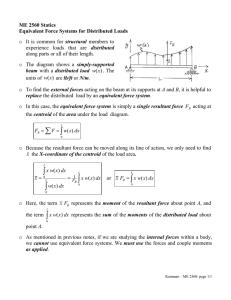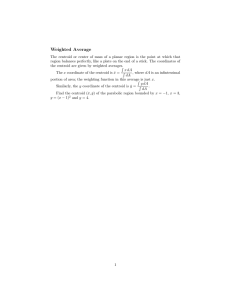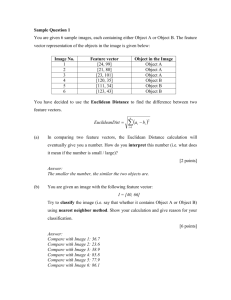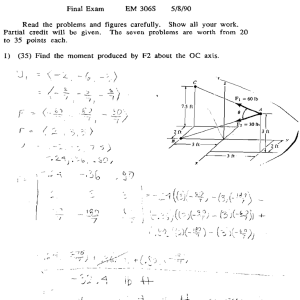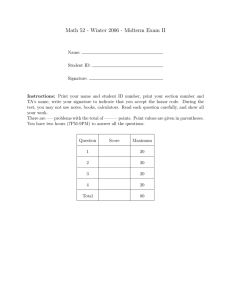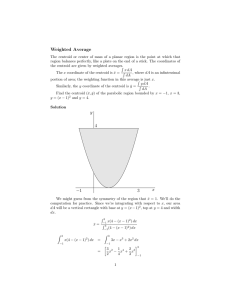9.1-9.2
advertisement
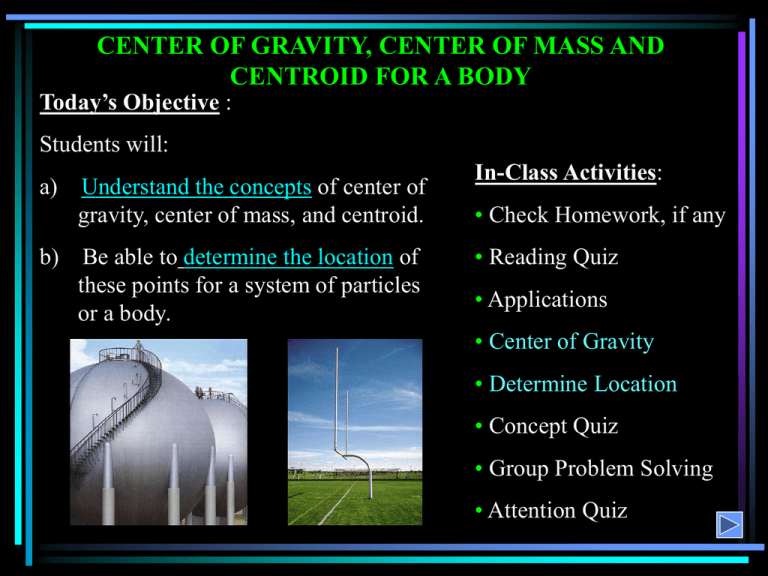
CENTER OF GRAVITY, CENTER OF MASS AND CENTROID FOR A BODY Today’s Objective : Students will: a) b) Understand the concepts of center of gravity, center of mass, and centroid. Be able to determine the location of these points for a system of particles or a body. In-Class Activities: • Check Homework, if any • Reading Quiz • Applications • Center of Gravity • Determine Location • Concept Quiz • Group Problem Solving • Attention Quiz READING QUIZ 1. The _________ is the point defining the geometric center of an object . A) center of gravity B) center of mass C) centroid D) none of the above 2. To study problems concerned with the motion of matter under the influence of forces, i.e., dynamics, it is necessary to locate a point called ________. A) center of gravity B) center of mass C) centroid D) none of the above APPLICATIONS To design the structure for supporting a water tank, we will need to know the weights of the tank and water as well as the locations where the resultant forces representing these distributed loads are acting. How can we determine these weights and their locations? APPLICATIONS (continued) One concern about a sport utility vehicle (SUVs) is that it might tip over while taking a sharp turn. One of the important factors in determining its stability is the SUV’s center of mass. Should it be higher or lower for making a SUV more stable? How do you determine its location? 4N 3m 1m CONCEPT OF CG & CM The center of gravity (G) is a point which locates the resultant weight of a system of B particles or body. • A G 3N 1N From the definition of a resultant force, the sum of moments due to individual particle weight about any point is the same as the moment due to the resultant weight located at G. For the figure above, try taking moments about A and B. Also, note that the sum of moments due to the individual particle’s weights about point G is equal to zero. Similarly, the center of mass is a point which locates the resultant mass of a system of particles or body. Generally, its location is the same as that of G. CONCEPT OF CENTROID The centroid C is a point which defines the geometric center of an object. The centroid coincides with the center of mass or the center of gravity only if the material of the body is homogenous (density or specific weight is constant throughout the body). If an object has an axis of symmetry, then the centroid of object lies on that axis. In some cases, the centroid is not located on the object. CG / CM FOR A SYSTEM OF PARTICLES (Section 9.1) Consider a system of n particles as shown in the figure. The net or the resultant weight is given as WR = W. Summing the moments about the y-axis, we get ~ ~ ~ x WR = x1W1 + x2W2 + ……….. + xnWn ~ where x1 represents x coordinate of W1, etc.. Similarly, we can sum moments about the x- and z-axes to find the coordinates of G. By replacing the W with a M in these equations, the coordinates of the center of mass can be found. CG / CM & CENTROID OF A BODY (Section 9.2) A rigid body can be considered as made up of an infinite number of particles. Hence, using the same principles as in the previous slide, we get the coordinates of G by simply replacing the discrete summation sign ( ) by the continuous summation sign ( ) and W by dW. Similarly, the coordinates of the center of mass and the centroid of volume, area, or length can be obtained by replacing W by m, V, A, or L, respectively. STEPS FOR DETERMING AREA CENTROID 1. Choose an appropriate differential element dA at a general point (x,y). Hint: Generally, if y is easily expressed in terms of x (e.g., y = x2 + 1), use a vertical rectangular element. If the converse is true, then use a horizontal rectangular element. 2. Express dA in terms of the differentiating element dx (or dy). ~ , ~y ) of the centroid of the rectangular 3. Determine coordinates (x element in terms of the general point (x,y). 4. Express all the variables and integral limits in the formula using either x or y depending on whether the differential element is in terms of dx or dy, respectively, and integrate. Note: Similar steps are used for determining CG, CM, etc.. These steps will become clearer by doing a few examples. EXAMPLE Given: The area as shown. Find: The centroid location (x , y) Plan: Follow the steps. Solution x,y • • ~ ~ 1. Since y is given in terms of x, choose dA as a vertical rectangular strip. x,y 2. dA = y dx 3. ~ x = x and = (9 – x2) dx ~ y = y/2 EXAMPLE (continued) ~ 4. x = ( A x dA ) / ( A dA ) 3 = 2) d x x ( 9 – x 0 3 2) d x ( 9 – x 0 = [ 9 (x2)/2 – (x4) / 4] 03 [ 9 x – (x3) / 3 ] 3 0 = ( 9 ( 9 ) / 2 – 81 / 4 ) / ( 9 ( 3 ) – ( 27 / 3 ) ) = 1.13 ft 3 ~ y = A y dA A dA = ½ 0 ( 9 – x2) ( 9 – x2) dx 3 2) d x ( 9 – x 0 = 3.60 ft CONCEPT QUIZ 1. The steel plate with known weight and nonuniform thickness and density is supported as shown. Of the three parameters (CG, CM, and centroid), which one is needed for determining the support reactions? Are all three parameters located at the same point? A) B) C) D) (center of gravity, no) (center of gravity, yes) (centroid, yes) (centroid, no) 2. When determining the centroid of the area above, which type of differential area element requires the least computational work? A) Vertical B) Horizontal C) Polar D) Any one of the above. GROUP PROBLEM SOLVING Given: The area as shown. Find: The x of the centroid. Plan: Follow the steps. Solution (x1,,y) (x2,y) 1. Choose dA as a horizontal rectangular strip. 2. dA = ( x2 – x1) dy = ((2 – y) – y2) dy 3. x = ( x1 + x2) / 2 = 0.5 (( 2 – y) + y2 ) GROUP PROBLEM SOLVING (continued) 4. x ~ ( A x dA ) / ( A dA ) = A dA = 0 1 ( 2 – y – y2) dy [ 2 y – y2 / 2 – y3 / 3] 01 = 1.167 m2 1 ~ A x dA = 0 0.5 ( 2 – y + y2 ) ( 2 – y – y2 ) dy x = 1 = 0.5 0 ( 4 – 4 y + y2 – y4 ) dy = 0.5 [ 4 y – 4 y2 / 2 + y3 / 3 – y5 / 5 ] 1 = 1.067 m3 0 1.067 / 1.167 = 0.914 m ATTENTION QUIZ 1. If a vertical rectangular strip is chosen as the differential element, then all the variables, including the integral limit, should be in terms of _____ . A) x B) y C) z D) Any of the above. 2. If a vertical rectangular strip is chosen, then what are the values of ~ ~ x and y? A) (x , y) B) (x / 2 , y / 2) C) (x , 0) D) (x , y / 2)


